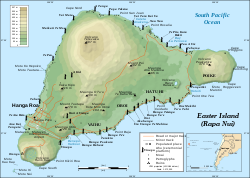Pulo Paskah
Pidangan
- Pikeun album beunang Kris Kristofferson, tempo Easter Island (album).
Koordinat: 27°7′S 109°22′W / 27.117°S 109.367°W
| Rapa Nui Isla de Pascua Pulo Paskah |
||||||
|---|---|---|---|---|---|---|
|
||||||
 |
||||||
| Ibu kota | Hanga Roa | |||||
| Basa resmi | Basa Spanyol, basa Rapa Nui [1] | |||||
| Grup étnis (2002) | Rapanui 60%, Eropa ataea mestizo 39%, Amérindian 1% | |||||
| Démonim | Rapa Nui atawa Pascuense | |||||
| Pamaréntah | Wewengkon husus Cili[2] | |||||
| - | Gubernur | Carmen Cardinali | ||||
| - | Mayor | Luz Zasso Paoa | ||||
| Anéksasi | ka Cili | |||||
| - | Traktat ditandatanganan | 9 Séptémber 1888 | ||||
| Aréa | ||||||
| - | Total | 163,6 km² 63,1 mil² |
||||
| Populasi | ||||||
| - | Perkiraan 2011 | 5.034[3] | ||||
| - | Sénsus 2002 | 3.791 | ||||
| - | Kapadetan | 30,77 /km² 79,78 /mil² |
||||
| Mata uang | Peso (CLP) |
|||||
| Zona wanci | EAST (UTC−6) | |||||
| - | Usum panas (DST) | EASST (UTC−5) | ||||
| TLD Internét | .cl | |||||
| Kode telepon | ++56 32 | |||||
Pulo Paskah (basa Rapa Nui: Rapa Nui, basa Spanyol: Isla de Pascua) mangrupa hiji pulo Polinésia di Samudra Pasifik Kidul, dina titik nu pangkidulna ti Sagitilu Polinésia. Hiji wewengkon husus Cili nu dianéksasi dina 1888, Pulo Paskah katelah ku 887 patung monuméntalna, nu disebut moai.
Pulo Paskah diklaim salaku pulo nu pangkaisolasina di dunya nu didumukan.[4]

Tempo ogé
[édit | édit sumber]Réferénsi
[édit | édit sumber]- Catetan
- ↑ Portal Rapa Nui Archived 2012-01-14 di Wayback Machine
- ↑ Pending the enactment of a special charter, the island will continue to be governed as a province of the Valparaíso Region.
- ↑ National Statistics Office (INE).
- ↑ "Welcome to Tapa Nui - Isla de Pascua - Easter Island" Archived 2011-11-01 di Wayback Machine on Portal RapaNui, the island's official website
- Bibliograpi
- McLaughlin, Shawn (2007). The Complete Guide to Easter Island. Los Osos: Easter Island Foundation.
- Diamond, Jared (2005). Collapse. How Societies Choose to Fail or Succeed. New York: Viking. ISBN 0-14-303655-6.
- Fischer, Steven Roger (1995). "Preliminary Evidence for Cosmogonic Texts in Rapanui's Rongorongo Inscriptions". Journal of the Polynesian Society (104): pp. 303–21.
- Fischer, Steven Roger (1997). Glyph-breaker: A Decipherer's Story. New York: Copernicus/Springer-Verlag.
- Fischer, Steven Roger (1997). RongoRongo, the Easter Island Script: History, Traditions, Texts. Oxford and New York: Oxford University Press. ISBN 0198237103.
- Heyerdal, Thor (1961). Thor Heyerdahl & Edwin N. Ferdon Jr., ed. The Concept of Rongorongo Among the Historic Population of Easter Island. Stockholm: Forum.
- Heyerdal, Thor Aku-Aku; The 1958 Expedition to Easter Island.
- Metraux, Alfred (1940). "Ethnology of Easter Island". Bernice P. Bishop Museum Bulletin (Honolulu: Bernice P. Bishop Museum Press) (160).
- Routledge, Katherine (1919). The Mystery of Easter Island. The story of an expedition. London. ISBN 0404142311.
- Steadman, David (2006). Extinction and Biogeography in Tropical Pacific Birds. University of Chicago Press. ISBN 978-0-226-77142-7.
- Bacaan salajengna
- Altman, Ann M. (2004). Early Visitors to Easter Island 1864–1877 (translations of the accounts of Eugéne Eyraud, Hippolyte Roussel, Pierre Loti and Alphonse Pinart; with an Introduction by Georgia Lee). Los Osos: Easter Island Foundation.
- Englert, Sebastian F. (1970). Island at the Center of the World. New York: Charles Scribner's Sons.
- Hunt, Terry L. (September–October 2006). "Rethinking the Fall of Easter Island". American Scientist (94): p. 412.
- Lee, Georgia (1992). The Rock Art of Easter Island. Symbols of Power, Prayers to the Gods. Los Angeles: The Institute of Archaeology Publications. ISBN 0917956745.
- Thomson, William J. (1891). "Te Pito te Henua, or Easter Island. Report of the United States National Museum for the Year Ending June 30, 1889". Annual Reports of the Smithsonian Institution for 1889 (Washington: Smithsonian Institution): pp. 447–552.in Google Books
- van Tilburg, Jo Anne (1994). Easter Island: Archaeology, Ecology and Culture. Washington D.C.: Smithsonian Institution Press. ISBN 0714125040.
- Vergano, Dan. "Were rats behind Easter Island mystery?" USA Today (November 15, 2009)
Tumbu kaluar
[édit | édit sumber]| Wikimedia Commons mibanda média séjénna nu patali jeung Easter Island. |
![]() Tempo ogé Pulo Paskah di Wikivoyage
Tempo ogé Pulo Paskah di Wikivoyage
| Artikel ngeunaan géografi ti hiji nagara atawa wewengkon ieu mangrupa taratas, perlu disampurnakeun. Upami sadérék uninga langkung paos perkawis ieu, dihaturan kanggo ngalengkepan. |







